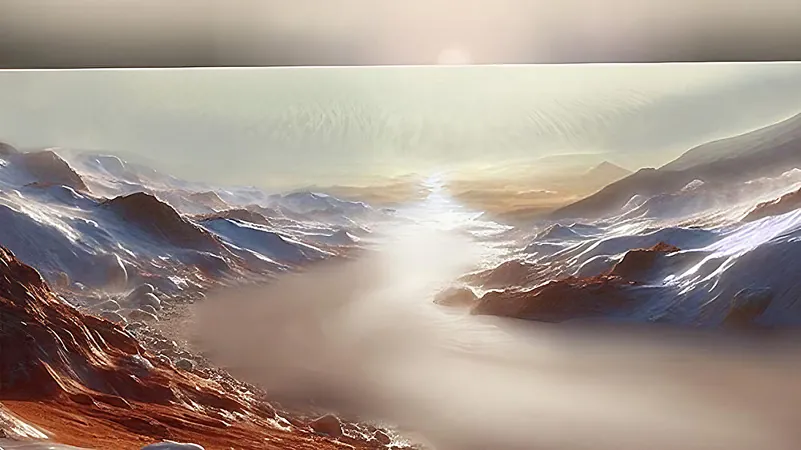
Unlocking Mars: How Ancient Ice Sheets Birthed Giant Rivers on the Red Planet
2024-11-04
Author: Wei Ling
On ancient Mars, a stunning landscape emerged, where rivers flowed freely and expansive lakes—some as large as the Mediterranean Sea—formed under thick protective layers of ice. Fresh revelations from innovative research led by Planetary Science Institute's Research Scientist, Peter Buhler, shed light on how this incredible transformation took place approximately 3.6 billion years ago.
This groundbreaking study, published in the Journal of Geophysical Research: Planets, details a period when carbon dioxide from Mars' atmosphere solidified and settled atop polar ice, creating a vital thermal blanket. This unique phenomenon allowed heat from the planet's core to accumulate, resulting in immense pressure that melted an astonishing portion of Mars' water inventory, enabling water to flow dramatically across the Martian surface without necessitating a rise in temperature.
Buhler’s previous work focused primarily on the contemporary carbon dioxide cycle on Mars. In this latest study, he expanded his model to encompass the interactions between carbon dioxide and the Martian regolith—a mixture of sand, rocks, and minerals. By integrating regolith into the equation, Buhler's model effectively illustrates the comprehensive carbon dioxide cycle, connecting the atmosphere, the surface, and the polar caps.
"The model accounts for significant geological features on Mars—such as the largest lake, valleys, and extensive esker formations that are remnants of ancient rivers flowing beneath ice sheets—all through processes observable today," Buhler stated. This model accounts for historical conditions of carbon dioxide collapse, marking a pivotal shift in our understanding of the Martian landscape.
Mars’ rotational tilt plays an essential role in this cycle, creating alternating periods of heating and cooling. Presently, much of its carbon dioxide exists within the regolith, layered in a singular molecular form around grains of sand and rock. During conditions when the planet's spin is upright, carbon dioxide escapes the regolith as temperatures rise, eventually depositing on the polar ice caps. Conversely, when Mars tilts more dramatically and the poles gain sunlight, carbon dioxide sublimates back into gas, re-entering the regolith, illustrating a dynamic and cyclical interplay.
For this study, Buhler modeled a dense 0.4-mile layer of carbon dioxide sitting atop a 2.5-mile thick water ice layer. This thick carbon dioxide cap acts as an insulator, effectively trapping heat and increasing pressure beneath it. Remarkably, this process could have melted considerable amounts of water, saturating the Martian crust and leading to the formation of subglacial rivers beneath the ice.
Buhler’s model predicts that as meltwater flowed, it would carve out rivers at the base of the ice sheet, resulting in the formation of elongated geological features known as eskers. These structures observed near Mars’ south pole lend credence to the idea that subglacial rivers were once prevalent in the planet's history.
"This mechanism explaining the existence of eskers without needing to invoke climatic warming is a significant step forward,” Buhler remarked. The meltwater would eventually carve channels leading to vast basins, filling regions like the Argyre Basin with enough water to flood and overflow into the northern plains.
According to Buhler, these surges of water likely occurred multiple times over hundreds of millions of years, suggesting a complex and dynamic hydrologic cycle driven by Mars’ unique atmospheric conditions.
What sets this research apart is its capacity to illustrate a Mars where water played a more central role than previously believed, without relying on speculative warming events to explain geological features. "This model provides a fresh perspective on Mars’ ancient water cycle, illuminating the possibility of a vital pole-to-equator movement of water that has shaped our understanding of the planet’s climatic history,” Buhler concludes.
As more data unfolds from ongoing studies, the revelations about ancient Mars may alter our narrative around this enigmatic planet, igniting excitement among researchers dedicated to unraveling its long-lost secrets, potential for past life, and prospects for future exploration. Stay tuned as we continue to unveil the story of water on Mars!



 Brasil (PT)
Brasil (PT)
 Canada (EN)
Canada (EN)
 Chile (ES)
Chile (ES)
 España (ES)
España (ES)
 France (FR)
France (FR)
 Hong Kong (EN)
Hong Kong (EN)
 Italia (IT)
Italia (IT)
 日本 (JA)
日本 (JA)
 Magyarország (HU)
Magyarország (HU)
 Norge (NO)
Norge (NO)
 Polska (PL)
Polska (PL)
 Schweiz (DE)
Schweiz (DE)
 Singapore (EN)
Singapore (EN)
 Sverige (SV)
Sverige (SV)
 Suomi (FI)
Suomi (FI)
 Türkiye (TR)
Türkiye (TR)